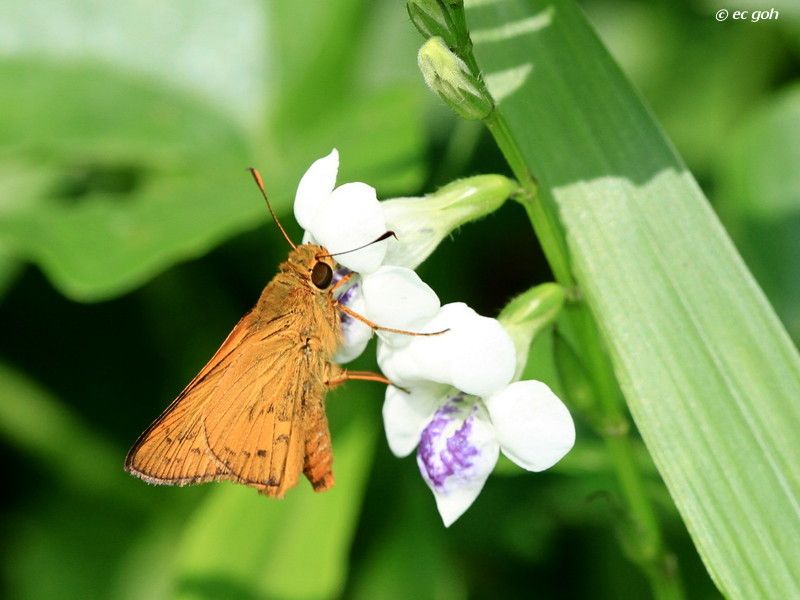DFNP on 1 Jul 2012...
#1 - Eurema simulatrix tecmessa
#2 - The Chocolate Grass Yellow (Eurema sari sodalis)
#3 - The Malay Lacewing (Cethosia hypsea hypsina)
#4 - The Common Dartlet (Oriens gola pseudolus)
#5 -



DFNP on 1 Jul 2012...
#1 - Eurema simulatrix tecmessa
#2 - The Chocolate Grass Yellow (Eurema sari sodalis)
#3 - The Malay Lacewing (Cethosia hypsea hypsina)
#4 - The Common Dartlet (Oriens gola pseudolus)
#5 -



EC Goh
You seems to have found something new.
1 is not Eurema simulatrix.
In simulatrix the forewing cell have 2 'spots'. & the hindwing base of space 7 is strongly marked with a spot (base of where the round spot is.)
There is only one forewing cell spot.
E. sari can be discounted by its large patch.
In E. andersonii the hindwing costal streak in space 7 extends & lines up with the cell-end bar. (See the pics in the checklist.)
The streak & the cellend bar are totally out of position here.
Here are additional images of E. andersonii to show how the costal streak in space 7 lines up & joins the cellend bar.
http://yutaka.it-n.jp/pie/20600001.html
This can only be the male Eurema lacteola.
5. is Cehprenes acalle.
Both the Cephrenes species have the forewing spots 4 & 5 long thin & rectangular on the underside.
TL Seow
PS. One has to be mindful of a E. hecabe that has lost one of its cellspot.
Two features that help to confirm the ID.
1. There is a greenish tinge to the yellow. Compare to the pic of E. sari (same camera, same settings).
2. The hindwing of E. hecabe is somewhat quadrate or squarish.See.
http://www.butterflycircle.com/check...owbutterfly/25
Unfortunately pics of E. lacteola on the net turned out to E. hecabe.
Last edited by Psyche; 02-Jul-2012 at 09:27 AM. Reason: PS
I've been looking at many of the specimens collected over the past 20 years from Singapore, and have yet to find two species that were present in the checklists of the early authors - E. lacteola and E. ada.
Two come close to E. lacteola but when I had a comparison of the upperside, which also has some ID features in C&P4's key, they turned out to be more likely E. hecabe than E. lacteola.
As Seow said, then there are aberrants where the cell spots are obscured, or missing (our earlier debates about the regular appearances of "no-spot grass yellows" refer)
Hence unless we have a shot of a pristine specimen and a voucher one that can validate the physical characteristics, I would hesitate to nail down an ID with full confidence. With these Eurema, there seems to be a wide variation of spots and markings.
Teo TP, on the other hand, may have more conclusive evidence of the presence of E. lacteola with more specimens from the Singapore front to compare. Perhaps he can chip in on this discussion when he returns from his trip to Malaysia.
Agreed Khew, that a vouchered specimen is essential here for close scrutiny.
However, it is not possible to separate lacteola from hecabe from the upperside markings.
I think that is why some females of hecabe are labelled lacteola on the net because of its paler colour, although the underside shows 2 cell spots.
A female will removes all doubts as it is pale greenish white.
It is strange that no pic of E. lacteola are seen on the net.
TL Seow
You're right. Got confused with the key about the inner edge of the black border in spaces 1a and 1b sloping towards the base. Both hecabe and lacteola are similar in this aspect.
Yes, it's interesting that there appear to be no reliable shots of lacteola on the web.
In taking a good look & blowing up the image, there is a definite spot at the base of space 7 on the hindwing. This is seen only in E. blanda & simulatrix.
A search thru the web shows the square-cut brown patch on the forewing apex is seen only with E. simulatrix & sari, and rarely & incomplete in E. blanda.
The cleft appearance is typical of E. simulatrix.
Without going into lenghty explanation this is E. simulatrix although it has only one cell spot.
EC, an apology here. You were right all along.
TL Seow
Dr. Seow, thanks.
Brian and I did not go into that detail in ID-ing it but it was enriching reading Khew's and your analysis. I tried going back to the same spot but did not find the same butt.
EC Goh
There are Terias lacteola* from Singapore. I did a comparison of text and keys in both C&P 4 and Prof. Osamu Yata's book (Butterflies of the SEA Islands volume 2). C&P 4 gave information and separation keys on 9 Sin-Malaysian Eurema species and Yata described 16 SEA species with photos, figured the wing patterns for discrimination of the 16 species, a set of separation keys for the Eurema groups, distribution maps and genitalia of every species, detail comments on distribution, seasonal forms, variations of hecabe and lacteola. Both books stated that the examination of valves is the most reliable method to differentiate the two species.
The original description of E. lacteola lacteola by Distant in 1886 was from Singapore (Yata et al, 1985). Although C&P 4 (page 398) gave a [S] for lacteola but I did encountered this species on many occasions locally. I was surprised that no photo of this species from BC member. Like the common Ypthimus species, is it because it looks like hecabe, so common that nobody wants to take a close look on it?
Teo T P
*Please refer to "Updating the Butterflies of the Malay Peninsula" page 7 by J. N. Eliot (MNJ vol. 59, no. 1: 1-49, 2006).